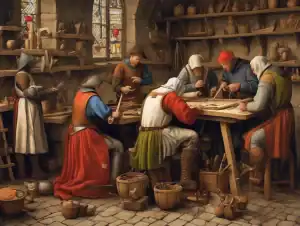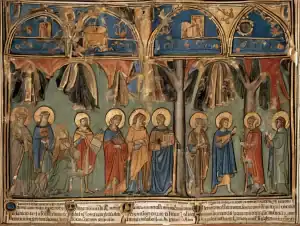Anglo Saxon art refers to the various forms of art produced by the Anglo-Saxons in England from the 5th to 11th centuries.

During this period, the Anglo-Saxon society underwent significant changes many of which are reflected in the extant specimens of Anglo Saxon art.

Early Anglo Saxon art, for instance, reflects the migratory period during which the Germanic tribes of Angles, Jutes and Saxons made their way from Continental Europe to the British Isles.
As they settled in England and created a veritable and powerful kingdom over time, the outlook of their art evolved to reflect affluence and increased sophistication.

Few extant specimens of Anglo-Saxon artwork remain today. Chief among these is the architecture dating back to the early and late Anglo-Saxon period. The Bayeux Tapestry is considered a vital extant piece of Anglo Saxon art.
Commissioned soon after the Norman invasion of England in 1066, the Tapestry reflects the style of embroidery practised by the Anglo Saxons and other aspects of their artistic style.
Anglo Saxon Metalwork
Metalwork was one of the preeminent Anglo Saxon art forms. Anglo Saxon metalwork is considered one of the finest of the time, popularly in demand in Continental Europe through different periods between the 6th and 11th centuries.

Anglo Saxons used precious metals such as gold and silver in creating different products of metal such as shoulder clasps, brooches, belt buckles and helmets.
Anglo-Saxon skill in gold-carving was known throughout Western Europe by the 10th century. Many extant examples of Anglo Saxon metalwork have been recovered from ship-burials of Anglo Saxon nobles.

Characteristics of Anglo Saxon Art
Anglo Saxon artwork was characterised by the use of especially bright and vivid colours when it came to illustrated manuscripts. Anglo Saxon metalwork was characterised by highly intricate and fine work.

Anglo Saxon Art Fast Facts
- Anglo Saxon art was recognisable by the extensive use of colours and brightness in the artwork.
- Anglo Saxon art originated with the Germanic Anglo Saxons in England.
- Anglo Saxon art dates from the 5th century until the 11th century.
- Anglo Saxon art was influenced by the British Celts during the early period and by the Franks towards the later period.
- Anglo Saxon art can be seen in a number of museums across England.
Anglo Saxon Illuminated Manuscripts
One of the earliest forms of literacy and literature in Anglo-Saxon England was inspired by the Christian missionaries. The missionaries first arrived in Ireland and by the 6th century, Anglo Saxon society began to accept Christianity.

This propelled the establishment of monasteries and a trend of attaining literacy. By the 7th century, Anglo Saxon was producing richly colourful and beautifully illustrated Bible manuscripts.
The style of illuminating the manuscripts as can be seen in extant Anglo Saxon samples is inspired by Celtic, Germanic and Italian styles, often a fine mixture of diverse influences.

By the 9th century, Anglo Saxon missions were reaching as far as the Carolingian Empire and exported their style of illuminating the manuscripts with them.
Anglo Saxon Art Top 5
- Bayeux Tapestry which dates back to the 1070s is an example of Anglo Saxon embroidery.
- Fuller Brooch which dates back to the 9th century is an example of Anglo Saxon metalwork.
- The St. Cuthbert Gospel which dates back to the early 8th century is an example of Anglo Saxon leather-binding decoration.
- The Reliquary Cross which dates back to the 10th century is an Anglo Saxon reliquary cross with an ivory figure of Christ.
- The Franks Casket dates back to the 8th century and contains intricate carvings on a whale’s bone chest.






